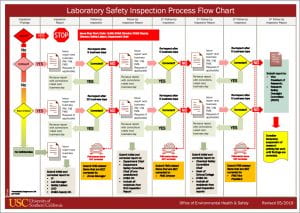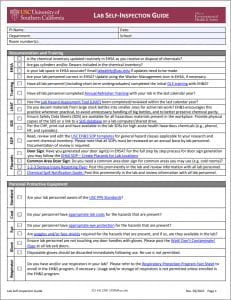USC EH&S conducts regular lab inspections to:
- Minimize the risk of injury or illness to laboratory workers by ensuring that they have the training, information, and support needed to work safely in the laboratory.
- Assess and reduce the hazard conditions in the laboratory.
- Ensure that labs are in compliance with applicable local, state and federal regulations.
- Assist faculty, staff, and students in establishing a safe and hygienic work environment.



What’s New
If the EH&S Chemical Inventory team has already visited your lab to certify your chemical inventory, your inspection will now be handled primarily through the Risk & Safety Solutions (RSS) application.
Training
Ensure all lab workers meet the minimum EH&S training requirements prior to beginning work in the laboratory. Refer to the Training Catalog for the list of required safety courses. View the schedule of in-person (Zoom) classes by visiting the Registration page.
At a minimum, every lab member is required to complete the General Lab Safety Training (GLS) followed by Annual Refresher Training provided by the lab supervisor or PI as detailed in the Annual Safety Refresher Training Memo.
A signed Site-Specific Training Record (SSTR) and certificate for all required training must be on file for every lab worker.
Standard Operating Procedures
Lab-specific Standard Operating Procedures (SOP) shall be available for all the highly hazardous materials and equipment. View the SOP webpage for templates of general hazard class SOPs. Use the templates to produce SOPs that address the storage and handling of hazardous chemicals in your laboratory.
- Researchers must maintain SOPs as hard copies placed in a labeled three ring binder and/or as labeled electronic files on a computer/server. All lab personnel must have ready access to both hard copy and electronic files.
- All SOPs that are read and understood by lab personnel must be signed and dated. This review shall be completed annually.
- Ensure that all new lab personnel read and review SOPs prior to beginning lab work.
Safety Data Sheets (SDS)
A Safety Data Sheet (SDS) for each hazardous chemical used in research labs shall be readily accessible to all lab personnel. SDSs may be acquired from chemical suppliers or via the SDS database. Researchers must maintain SDSs as hard copies placed in a labeled three ring binder and/or as labeled electronic files on a computer/server.
- Ensure that personnel read the SDSs for all the hazardous materials they intend to use.
- Ensure that a printed copy of a current SDS is physically available in the vicinity of any work with materials of very high acute health hazard (e.g. phenol, hydrofluoric acid, cyanides).
Laboratory Hazard Assessment Tool
Complete the Laboratory Hazard Assessment Tool (LHAT) annually or when there is a major modification to laboratory procedures and email it to labsafety@usc.edu.
EHSA
Information related to the CHEM permit (e.g., lab personnel, chemical inventory and door signs) in EHSA must be accurate and up-to-date prior to the General Lab Safety inspection.
- Update lab personnel to accurately reflect current staff. This can be maintained via the “Workers Management” tab in EHSA.
- Review and verify that your chemical inventory is up-to-date.
- Follow instructions in the EHSA SOP Create Placards for Lab Locations to create door sign(s) for your lab(s).
- Update door signs with PI and emergency personnel contact information.
Personal Protective Equipment (PPE)
Adhere to the USC Personal Protective Equipment (PPE) Standard and wear appropriate PPE as determined by the LHAT. Additional PPE (e.g., face shield, acid apron, disposable neoprene gloves over thicker butyl gloves) must be made available when working with highly hazardous materials such as hydrofluoric acid. Note: The use of respirators is not allowed outside of the Respiratory Protection Program.
Additional Things to Consider
- Emergency Notification and Incident Reporting – Ensure that the 1-2-3 Serious Injury Reporting Flyer is posted in a conspicuous area in each research lab. It is the PI’s responsibility to ensure that lab personnel are knowledgeable about the required reporting processes.
- A first-aid kit that meets California Code of Regulations Title 8, Section 1512 requirements must be available in the lab.
- If hydrofluoric acid is used in the lab, the first-aid kit must contain calcium gluconate. See the HF Safety Fact Sheet for additional info.
- If phenol is used in the lab, phenol specific first aid supplies are required. See the Phenol Safety Fact Sheet for additional information.
- Eliminate unnecessary clutter in the lab. Do not block exits, safety showers, eye wash stations, fire extinguishers, and posted evacuation plans.
- Chemical Spill – Ensure the Chemical Spill Response Notification Flyer is posted in a conspicuous area in each research lab. Additionally, a chemical spill kit must be available in the lab. Please see the Chemical Spill Kit Guide Sheet for more detailed information on appropriate spill kit materials.
Chemical Hygiene Plan
Update hard or digital copies of your Lab Safety Manual to include the current revision of the Chemical Hygiene Plan (CHP)